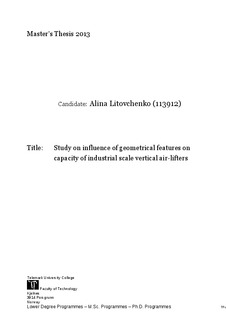Study on influence of geometrical features on capacity of industrial scale vertical air-lifters
Master thesis
Published version
Permanent lenke
http://hdl.handle.net/11250/2439037Utgivelsesdato
2015-10-09Metadata
Vis full innførselSamlinger
Originalversjon
Litovchenko, L . Study on influence of geometrical features on capacity of industrial scale vertical air-liftersl. Master thesis, Telemark University College, 2013Sammendrag
The main aim of this study was to investigate the influence of operating conditions and geometrical features (fluidization air flow rate QFA, transport air flow rate QTA, and nozzle position Z) on mass flow rate of solids in vertical air-lifters. Results from an experimental investigation that was done with two different bulk materials have been used in the present study. The large number of experiments for small scale vertical air-lifter has been carried out at the various operating conditions. In order to investigate wide range of experimental data and to formulate a tool for calculation of solids mass flow rate in vertical air-lifters, the mathematical model has been developed based on K ??model for pneumatic conveying systems. MatLab software has been used for simulation of model and for presenting the results. Calculations have been performed by two methods: based on average and instantaneous values of pressure drop coefficient Kst. The first method gives a significant error and the model cannot be used for prediction of mass flow rate of solids for vertical air-lifters. The best result was achieved based on online calculations of pressure drop coefficient and it also gave satisfactory results for predicting solids mass flow rate for different experimental conditions. It was found that the fluidization air flow rate QFA influences most the transport capacity. Transport air flow rateQTA also influences mass flow rate of solids in vertical air-lifters. The nozzle position Z has the least impact on capacity of vertical air-lifters.
